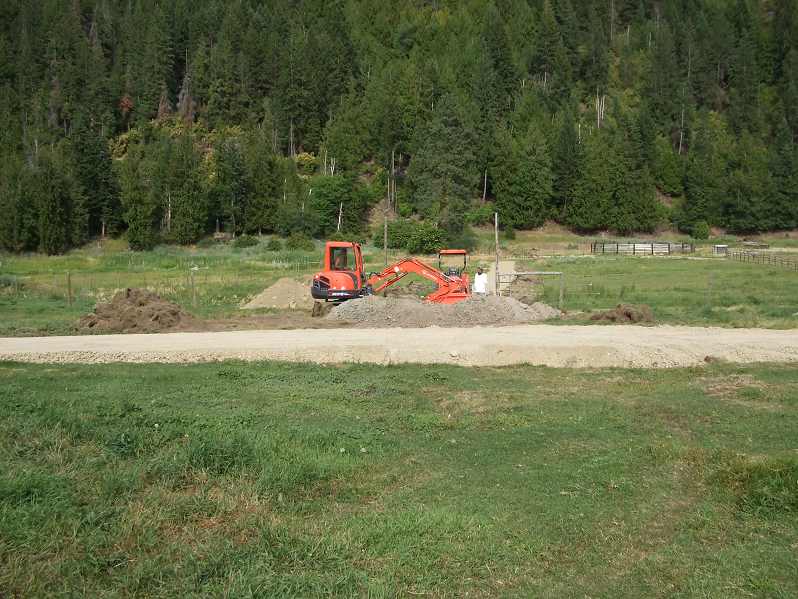
Establishing a New Building Site Is No Trivial Task...

In order to put something on the back of a property you need a road to get there. The first challenge. Actually; the road (driveway) was one of the easiest tasks. The work was straight forward and the material costs were easily calculable. We came in way under budget. That's not to say it was easy. In fact. We had many snags.
The first snag was the second highway access. I wanted a large circular driveway to help facilitate loading and unloading of horses and for access to big trucks. Mostly for hay delivery. The Ministry of Transportation Highways 'MOTH' has a policy though of not allowing multiple access on numbered highways. Well our property is on highway 3A. Thats a numbered highway. The initial MOTH decision was no. I was very polite in my conversations with the highway department. I actually begged them.
Well I wasn't giving up that easy. I found the 'Canadian Transportation Act' documentation on the Internet and began reading. I noticed that there are distinctions describing different types of numbered highways. There are main arterial highways, Rural highways and my designation Scenic Highway. So, armed with my new information, I contacted MOTH. When I talked to my representative she said that my begging was so compelling that she talked to her supervisor about my request. That's where I found out that the multiple access restriction is not a 'rule', as I mentioned, it's a 'policy'. She informed me that the Ministry has flexibility (discretion) over this issue. Before I even got a chance to renegotiate, based on my new information, she told me to fill out the proper forms and submit my request and they would review it. Darn. I had a great argument. Including the fact that Shauna's grandfather Alfred Palmer built this highway as the supervisor for the Department of Transportation in the 1930's.
After about two weeks I called the Ministry back and talked to my representative. She was quite casual... Oh hello... Any word on my case... She informed me that they reviewed my request, assessed my property (that's about a two hour drive; one way), and mailed me out the permit paperwork early in the week. Wow that was fast. So I ran up to the mailbox (about 2km) and sure enough there was a package from the Ministry of Transportation Highways. Oh, I thanked her first of course.
Now here's the unexpected twist. Although I did get my second access it came in the form of a contract. What I was granted was the right to maintain a stretch of highway, to MOTH standards, for my own purposes. AKA. Driveway. Well Ok. So I signed the contract and sent it off to 'activate' (their term) the permit.
Now we can begin.
And of course... No driveway is complete without big poles in front. Here we are putting up the third of four poles in our driveway loop at the new access. In the background are the first two poles at the other end of the 50-meter diameter circular driveway at the original access.
Here's a view from the other side. The building site side that is. Well close enough anyway.
To reflect. Here is the view from the top of the circular driveway looking to the building site.
Ok... Enough confusion with the perspective. Here are the basement (foundation) footings. Inspected, poured and inspected. I love when the building inspector comes because I get these 'report-cards' that say 'passed'. I have proudly kept all my report-cards.
After footings come walls. Well... Walls need forms. We were able to rent the basic form hardware. Plywood, wailing-bars, corners, etc... However this was still no easy task. Not only do you have to construct framework that is true and level it's only job is to briefly contain several tons of concrete. A huge effort for only days use. And that's not including the effort to remove and return the rented form hardware.
We decided 'not' to pour the basement floor ourselves so we hired a young outfit, willing to work for a reasonable cost, and owning their own equipment. We had no concrete floor polishing equipment or experience. Even today, the basement floor looks almost like glass. Money well spent.
Note: the final 'top' surface of the basement floor is a little under one meter above the bottom of the footings. This is an important building code requirement. Structure must be below the frost line.
Stick framing it's called. Actually, I like the term. What you are seeing is the actual frame (basement) that the house will sit on. I didn't mention it before so I will now. The basement concrete walls are eight inches thick. So is the 'stick frame'. Well... 2x8 anyway. On 12 inch centers.
Note: Lumber costs were at an all time low. The additional labor costs were negligent to build the basement much heavier (thicker walls, tighter stud spacing, etc...) then the code required. Who could resist.
Here is a PDF of the plans submitted to the RDCK and Ministry of Highways, Transportation.
Finally... In the middle November. Two months plus late. The house arrived. And. Who would have ever thought. In Canada. Look at the house. We've set it. There's no snow, yet. And the sun is still shining. A little bit of good luck here I think.